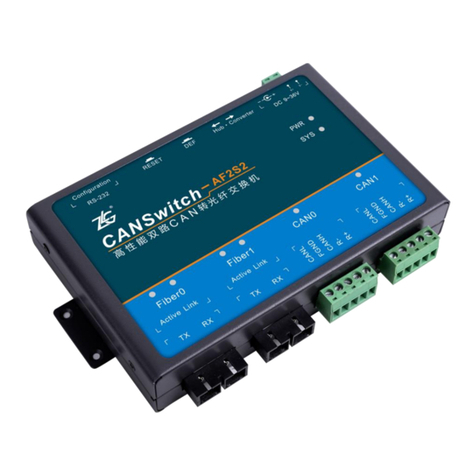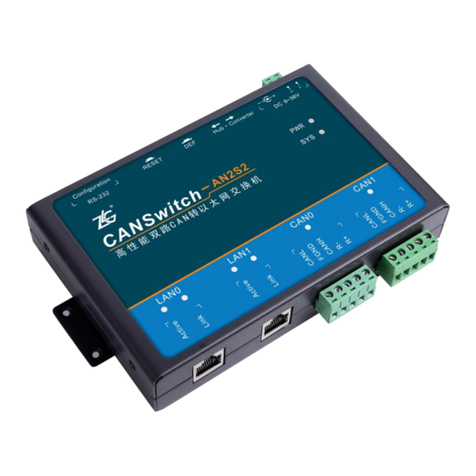
CANHub-AF2S2
Optical CAN Hub User Manual
©2021 Guangzhou ZLG Electronics Technology Co.,Ltd.
1
1. Functions
1.1 Product Overview
The CAN transmission medium can be twisted pair, optical fiber and coaxial cable. At
present, the CAN bus distributed system of twisted pair has been widely used, such as
automobile, elevator control, power system control. Various technologies have matured.
Compared with twisted pair and coaxial cable, the low transmission loss of optical fiber
greatly increases the transmission distance. In addition, the optical cable also has the
characteristics of not radiating energy, non-conducting, and non-inductive.Moreover, there
is no influence of crosstalk and mutual interference of optical signals in the optical cable, it
has excellent anti-EMI and EMC characteristics, and there is no safety problem caused by
inductive coupling in the cable.
The CANHub-AF2S2 realizes the transparent connection of multiple CANs, and
realizes multi-point connection of complex structures at the bus level; CANHub-AF2S2
enables the backbone network to have no branch length restrictions, and any two nodes in
the network can reach the protocol distance. The device has four communication ports.
Both twisted pair ports have independent CAN transceivers, which can double the number
of nodes. Therefore, this provides a free wiring method, and eliminates the drive limit of
the maximum number of nodes of the CAN transceiver on the system bus. The two optical
fiber ports enable CANHub-AF2S2 to be used in high-interference field environments,
especially in high-voltage applications, power applications and other environments. Each
port also provides an indicator for detecting bus activity and bus failure, which helps
observe the working status of the CAN bus network.
The CANHub-AF2S2 can be used in CAN networks with baud rates up to 1 Mbps. All
channels can work at different baud rates. CANHub-AF2S2 complies with CAN
specification 2.0A (11-bit CAN identifier) and 2.0B (29-bit CAN identifier). Transparent,
protocol-independent CAN message transmission is supported, making it suitable for a
variety of application scenarios.
After the CANHub-AF2S2 is connected to four CAN networks, if the user enables the
adaptive bus baud rate function, the two twisted pair channels in the device can detect the
bus baud rate of the CAN network (limited to nine standard CAN baud rates defined by
CiA: 1Mbps, 800Kbps, 500Kbps, 250Kbps, 125Kbps, 100Kbps, 50Kbps, 20Kbps,
10Kbps), and then automatically set the baud rate of these two channels to suit the two
different CAN networks. Because optical fiber communication is point-to-point, there is no
concept of adaptive baud rate.
The CANHub-AF2S2 can be configured with CAN message filters to ensure that only
the required data is transmitted to other CAN networks through the repeater; at the same
time, it also has a data routing function, which can selectively forward CAN messages
received by one channel to another channel. Therefore, the device can effectively reduce
the network load. CANHub-AF2S2 can be connected to the PC through the serial port to
configure its communication parameters; provide configuration software on Windows,
which is easy to use and supports configuration to take effect immediately. Once the





























